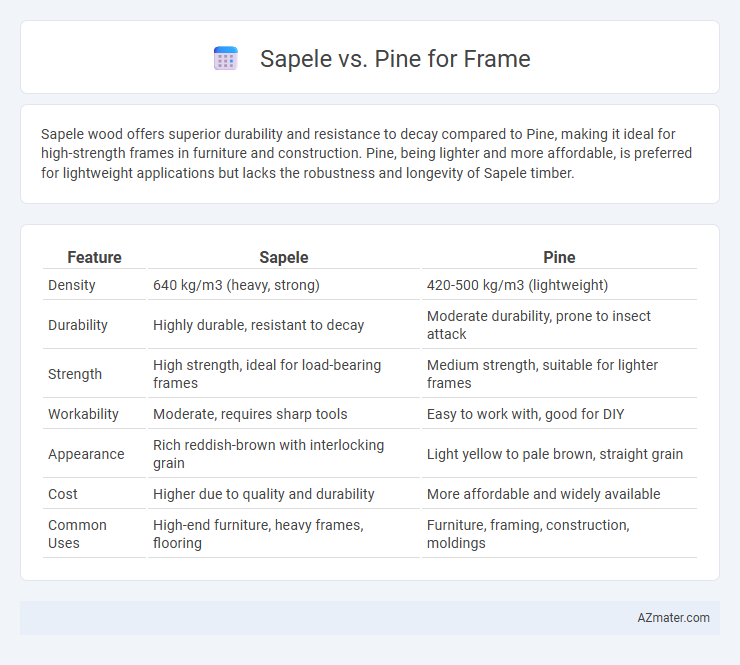Sapele wood offers superior durability and resistance to decay compared to Pine, making it ideal for high-strength frames in furniture and construction. Pine, being lighter and more affordable, is preferred for lightweight applications but lacks the robustness and longevity of Sapele timber.
Table of Comparison
| Feature | Sapele | Pine |
|---|---|---|
| Density | 640 kg/m3 (heavy, strong) | 420-500 kg/m3 (lightweight) |
| Durability | Highly durable, resistant to decay | Moderate durability, prone to insect attack |
| Strength | High strength, ideal for load-bearing frames | Medium strength, suitable for lighter frames |
| Workability | Moderate, requires sharp tools | Easy to work with, good for DIY |
| Appearance | Rich reddish-brown with interlocking grain | Light yellow to pale brown, straight grain |
| Cost | Higher due to quality and durability | More affordable and widely available |
| Common Uses | High-end furniture, heavy frames, flooring | Furniture, framing, construction, moldings |
Understanding Sapele and Pine: Wood Basics
Sapele, a hardwood from the African mahogany family, offers exceptional durability and a rich reddish-brown hue, making it a preferred choice for sturdy and aesthetically pleasing frames. Pine, a softwood with a lighter color and straight grain, is prized for its affordability and ease of workability, though it is less resistant to wear and insect damage. Understanding the density and grain patterns of Sapele versus the softer, more porous nature of Pine is crucial for selecting the right wood based on frame strength, appearance, and longevity requirements.
Appearance and Grain: Sapele vs Pine
Sapele exhibits a rich, reddish-brown color with an interlocking grain pattern that creates a shimmering, ribbon-like effect, making it ideal for elegant, high-end frames. Pine, in contrast, has a lighter, pale yellow hue with a straight, uniform grain, offering a rustic and casual look suitable for more traditional or country-style frames. The pronounced grain complexity in Sapele lends it a more sophisticated appearance, while Pine's simplicity contributes to a warm, cozy aesthetic.
Durability and Strength Comparison
Sapele, a hardwood with a Janka hardness rating of 1,410, offers superior durability and strength compared to pine, which typically ranges between 380 and 870. Sapele's dense grain structure provides excellent resistance to wear, impact, and decay, making it ideal for strong, long-lasting frames. In contrast, pine, being softer and more prone to dents and scratches, is better suited for lighter, less demanding framing applications.
Workability: Ease of Cutting and Shaping
Sapele wood offers moderate workability with a fine grain that allows for smooth cutting and shaping, although its interlocked grain can cause occasional tear-out. Pine is generally easier to work with due to its softer texture and straight grain, making it ideal for quick and precise cuts. When choosing between Sapele and Pine for frames, Pine's ease of machining outweighs Sapele's slight challenges in shaping tasks.
Resistance to Decay and Insects
Sapele wood demonstrates superior resistance to decay and insect attacks compared to pine, making it a durable choice for framing in humid and termite-prone areas. Pine, while cost-effective and easy to work with, is more susceptible to fungal decay and insect infestation without chemical treatment. The natural oils and dense grain structure of Sapele enhance its longevity and reduce maintenance requirements in outdoor or exposed framing applications.
Cost and Availability Analysis
Sapele offers a premium hardwood option with higher cost and moderate availability compared to pine, which is widely accessible and considerably more affordable. Pine's rapid growth and abundant supply reduce its market price, making it suitable for budget-conscious framing projects. Sapele's durability and aesthetic appeal justify its pricier investment despite limited regional availability.
Environmental Impact and Sustainability
Sapele offers a more sustainable choice for framing due to its status as a tropical hardwood often sourced from managed forests with certification programs like FSC ensuring responsible harvesting. Pine, commonly grown in fast-growing plantations, provides renewable timber with a lower carbon footprint throughout its lifecycle and supports reforestation efforts. Choosing Sapele supports biodiversity preservation in tropical regions, while pine's rapid growth rate and widespread availability contribute to reduced deforestation pressure and more efficient carbon sequestration.
Best Applications for Sapele Frames
Sapele is ideal for window and door frames due to its durability, natural resistance to rot, and fine interlocking grain that enhances dimensional stability. Its rich reddish-brown hue makes it a premium choice for visible frames in high-end cabinetry and furniture, where aesthetic appeal and strength are crucial. Unlike pine, which is softer and prone to dents, Sapele performs well in structural and exterior applications requiring long-term wear resistance and minimal maintenance.
Best Applications for Pine Frames
Pine frames are ideal for interior applications such as picture frames, window frames, and lightweight furniture due to their affordability, ease of workability, and good paint absorption. Pine's softwood characteristics allow for easier shaping and nailing compared to hardwoods like Sapele, making it a preferred choice for projects requiring frequent adjustments or detailed craftsmanship. While Sapele offers superior durability and resistance to decay, Pine is best suited for environments with minimal exposure to moisture and heavy wear.
Sapele vs Pine: Which is Best for Your Frame?
Sapele offers superior durability and a rich, reddish-brown finish that resists warping, making it ideal for high-quality frames requiring strength and longevity. Pine is a more affordable and lightweight option, with a paler color and softer texture, but it is prone to dents and may require more maintenance over time. Choosing between Sapele and Pine depends on whether durability and aesthetics or cost and ease of handling are your primary concerns for your frame project.

Infographic: Sapele vs Pine for Frame
 azmater.com
azmater.com